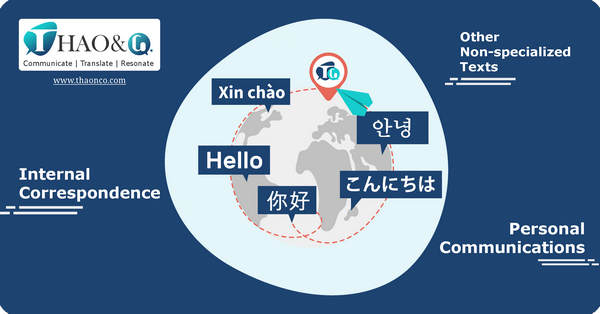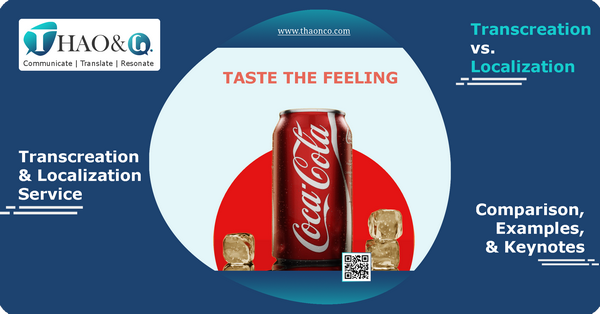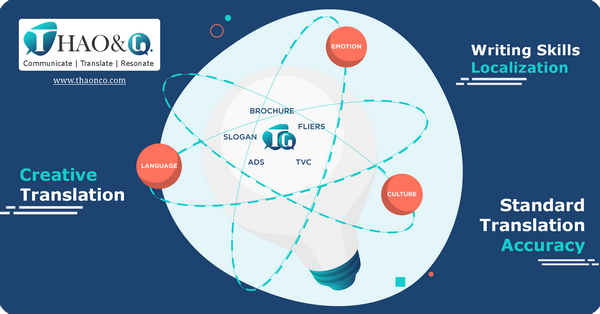Creative translation and localization are methods frequently employed by businesses when entering a new market. Both have similarities and differences in their objectives. To gain a better understanding of transcreation vs localization, let’s dive into this article.
Creative translation, also known as transcreation, involves transferring content from the source language to the target language while maintaining the tone and emotions of the original. This requires translators to possess not only translation skills but also creativity to ensure that the transcreation preserves the essence of the work.
Localization is the process of adapting content or products to fit a specific country or locale. This includes adaptations to language, culture, beliefs, lifestyle, and legal obligations. The localization process ensures that the product or content can be understood and utilized effectively.
The ultimate goal is to enhance the user experience, trust, and credibility of the product or brand. When a company aims to localize their product for a foreign market, they need to understand the language, culture, lifestyles, and legal obligations of the consumers in that country.
The company translates the product into the native language and updates any relevant terms to suit the language and culture of local people. They may also change product designs for the local market. Additionally, businesses might add new features to meet the needs of the new target consumers.
Creative translation and localization are closely connected concepts in the field of translation. Both demand creative thinking and the application of cultural knowledge and local experience in the translation process. Most importantly, both focus on the audience and strive to make the translated content easily understandable and relatable.
Transcreation vs localization: Which is optimal? As new translation solutions, both creative translation and localization make translations relevant to the audience’s needs and meet the standards of the modern translation industry. They respect local culture and try to maintain the distinctive features of the local language and culture during the translation process.
Transcreation and localization are often used together to produce high-quality translations. This combination ensures alignment with the needs of local customers.

Transcreation and localization are both crucial concepts in the field of translation, but they have some differences in:
The goal of transcreation is to create a high-quality translation that conveys the emotions and meaning of the original work. This is achieved by using words, sentence structures, and styles appropriate to the target language. Creative translation helps retain the essence and spirit of the original.
The goal of localization is to create a product or content that suits a specific locality or country. Localization involves a combination of elements to achieve effectiveness and accessibility for the local audience.
The accuracy of transcreation and localization depends on various factors, including the content of the source text and the client’s expectations. However, in some cases, a certain level of accuracy should be achieved to ensure that the content is appropriately conveyed.
A successful transcreation depends on the ability to express the meaning and emotions of the original work. This relies on the translator’s understanding of the original and their ability to convey its essence. Creative translation may involve modifying the original content to fit the context when necessary.
For example, Coca-Cola’s slogan “Taste the feeling” is creatively translated into Vietnamese as “Cảm nhận hương vị” (Feel the taste). While the wording is different, the transcreation still captures the essence and inspiration of the original slogan. Feel the taste is an excellent way to describe the feeling when drinking Coca-Cola. It also suits the Vietnamese cultural nuances and language.

The effectiveness of localization is evaluated based on whether the content is suitable for the local culture or target country. This includes using appropriate terms, symbols, colors, and images to align with the local culture and lifestyle.
Translators should also ensure compliance with legal obligations or beliefs to effectively adapt to the target culture.
The style and tone of transcreation and localization differ due to their distinct purposes.
In transcreation, the style and tone of the translation need to convey the exact emotions of the original work. Translators may need to use flexible language, employ wordplay, and even coin a new word to create a creative translation. This gives the audience an engaging and inspiring experience while conveying the message and spirit of the original.
In localization, the style and tone might differ from the original to ensure the content resonates with the local audience. Finesse is an important characteristic in Eastern cultures. Works from the East often exhibit delicacy and refinement, evident in every small detail. On the other hand, Western cultures value straightforwardness, and Western works typically express ideas and emotions directly and clearly.
Translators need to understand the cultural elements, word choices, and lifestyle of the local region so the audience can feel represented, which helps them understand the content in the most effective way.
Creative translation primarily taps into the audience’s emotions and creative imagination. Translators should use emotive words to create strong appeal and a lasting impression on the audience. This approach results in an enjoyable experience that effectively and attractively conveys the content.
The impact of localization on the audience is primarily about cultural familiarity and resonance. This method ensures the content is accurately and effectively transmitted to the local audience.

Choosing between transcreation and localization depends on the specific purpose and target audience:
Content types commonly need transcreation:
Content types commonly need localization:
To determine whether transcreation vs localization is needed, refer to the following checklist:
Transcreation and localization are essential processes for building a strong connection with local customers. This builds trust and drives sales revenue. It’s in your best interest to invest time and resources to succeed in the international market.
For quality creative translation and localization services, you may consider translation agencies with a proven track record. With years of experience in creative translation and localization, Thao & Co. Translation Agency has built a team of highly experienced native linguists. We offer specialized creative translation solutions and localization services for various languages and industries.
Visit Thao & Co.’s Get a Quote page for a free consultation and launch a successful campaign today!
